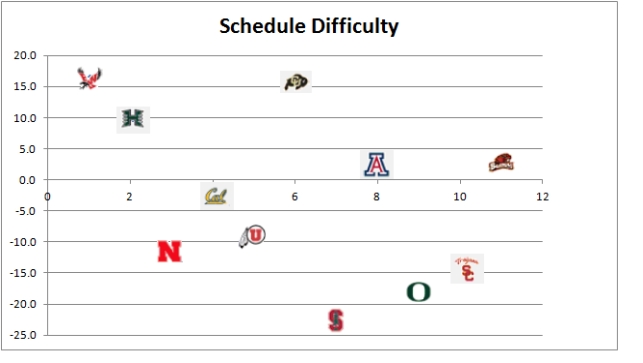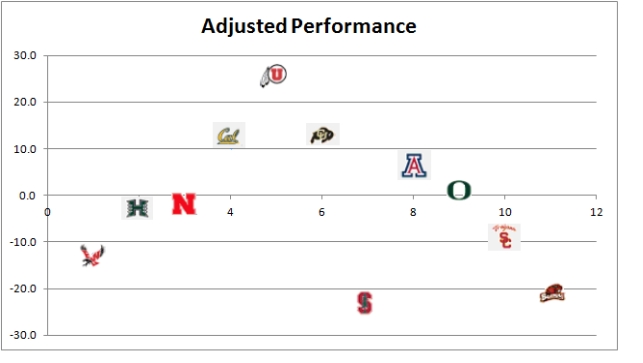After beating Colorado on Oct. 15, the University of Washington football team stood 5-1 and unbeaten in conference play. The Huskies climbed back into the rankings for just the second time in recent memory. Since then, Washington has won just once in five games. Now, the Huskies need to beat rival Washington State in the Apple Cup just to ensure a winning season. The polls are a distant memory.
Obviously, the schedule has been a factor. Before Saturday’s disappointing performance in Corvallis, Washington’s three losses had all come against teams ranked in the top 10 in the country this week — two of those three on the road. Have the Huskies really gone backward, or is the issue simply a matter of schedule?
To try to answer that question, I turned to Jeff Sagarin’s ratings. Using his Predictor rating for each team (the better measure of team quality) and adjusting for home field, I came up with projections for how Washington should have been expected to fare in each game. Graphically, here’s what that looks like:

In this case, because we’re looking at the expected point margin from the Huskies’ perspective, the hardest games are naturally at the bottom and the easiest games at the top. Naturally, Washington’s three easiest games came in the first six weeks of the season, while the top-10 matchups have been the most difficult. One interesting note is that if the Huskies had been perfectly consistent all season, they would actually have a worse record — 5-6 instead of 6-5. While Washington “should” have beaten Oregon State, wins over California and Utah were both unexpected given the Huskies’ overall level of play.
Now, let’s add in the actual results to come up with a schedule-adjusted measure of Washington’s game-by-game performance. That looks like this:
To some extent, there’s a parabola shape to the trend. The Huskies best stretch of the season by far came from Weeks 4-6, when they beat two solid Pac-12 foes in Cal and Utah and crushed Colorado more easily than expected. Before then, Washington had been no better than average and poor against Eastern Washington.
Over the last five weeks, it’s a little more difficult to show a pattern. The Huskies played relatively well against Arizona and as expected against Oregon. However, this stretch also includes the season’s worst two games, at Stanford and Oregon State.
One factor the statistics cannot incorporate is how the opponent was playing at the time of each game. When the Huskies beat the Bears, they were struggling. Only within the last five weeks or so has California surged behind an improved defense. Utah had backup quarterback Jon Hays getting his first D-I experience. While Washington deserves credit for slicing up a good Utes defense, Hays played about as poorly as expected in the second half. It took him several weeks to get comfortable, at which point Utah began to contend in the Pac-12 South. By contrast, the teams that were probably better at the time than the numbers indicate are the Huskies’ last two opponents. USC showed its strength last week in Eugene and Oregon State got a big first half from James Rodgers, who has been limited much of the season coming back from a knee injury.
Factoring that all in, I don’t think Washington was ever nearly as good as the record showed. The Huskies played at a top-25 level for precisely one game, at Utah. Until last Saturday, they had a single terrible performance, at Stanford. Basically every other game since the opening win over Eastern Washington had been within the amount of variation to be expected from game to game.
I’d basically throw out Saturday’s game in terms of evaluating Washington’s progress because Nick Montana started at quarterback. Since Montana posed almost no threat to the Beavers’ secondary, Oregon State was able to load up against the run and shut down Chris Polk after the first quarter. The Huskies’ defensive woes were to be expected given the way teams like Cal, Eastern and even Colorado have been able to move the football in the past. The two differences were that the Washington D was unable to get the stops in the red zone that had saved Nick Holt‘s unit in the past, and that Price wasn’t there to help the Huskies outscore their opponent in a shootout.
With Price presumably back as the starter on Saturday for the Apple Cup, we’ll have a better read on whether the team has really gone backwards. By the Sagarin method, the Huskies should be favored by 5.9 points against Washington State. A loss would be a sure sign Washington has in fact regressed, but a win would still allow the Huskies to head into bowl season on a positive note.


Pingback: Rethinking Expectations for the Huskies | after the buzzer